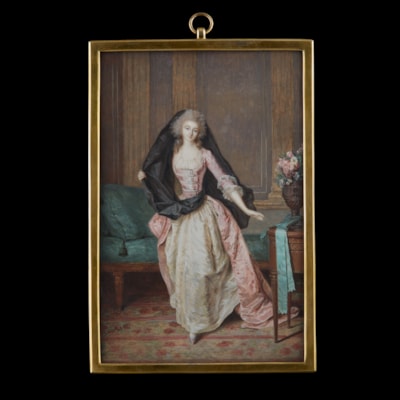ENGLISH SCHOOL (18th century)
Portrait miniature of William III, King of England (1650-1702)
After 1702
Watercolour on ivory
Ivory registration number: 9N3NGK34
Set into the bezel of a gold ring, the hoop engraved with floral chasing (size 7/O); later black leather ring box
Oval, 15 mm (⁵/₈ inch) high
SOLD
Both sovereigns were staunch patrons of the arts and their investment held a lasting effect on British Style, notably evidenced in the transformation of much of Hampton Court Palace’s facades from Tudor to Baroque. Portrait miniatures had been popular amongst courtiers and royals for over a century and William III upheld this trade by appointing Charles Boit as his court enameller in 1696. Other contemporary artists to whom miniatures of William III are attributed include Mary Beale, Benjamin Arlaud and Caspar Netscher. Whilst Boit was known to work from life, many miniatures painted on both vellum and ivory were copied from larger official royal portraits by court painters such as Sir Godfrey Kneller (1646-1723).[1] The head type here may have been adapted from Kneller’s full-length portrait of the King, datable to circa 1690. The head type here may have been adapted from Kneller’s full-length portrait of the King, datable to circa 1690.
During the English Civil War in the reign of Charles I, portrait miniatures set into rings were distributed amongst Royalists as a display of support for the King’s cause. Diplomatic and commemorative miniatures of this sort were popular in the seventeenth century, and it is possible that the present work may have been commissioned for courtiers with a similar commemorative intention. Given the suggested date of the portrait, this ring may have been commissioned to mourn the death of the King or a significant anniversary in his reign.
Two rings, also executed in watercolour on ivory, display akin compositions and appear to have been taken from the same portrait as the present miniature (Fig. 1. William III, English School 18th Century, sold: Bonhams Fine Portrait Miniatures, 22nd May 2003, lot 22; and Fig. 2. William III, unattributed and undated, Florence Court, National Trust). The beginning of the 18th century saw one of the most important technical innovations in miniature painting as vellum was replaced for ivory. In light of this, these rings may have been produced together at the turn of the century either during William’s reign or, more likely, just after. The setting for the ring also dates to the early 19th century, the chased shoulders, border and hoop mimicking the work of Rundell, Bridge and Rundell, the company who worked from William IV and Queen Victoria.[2]
[1] There are many variants of Kneller’s portrait of the King, and engravings showing variants on the head type, but the main source would be the full-length in the Royal Collection Trust RCIN 405675.
[2] For example, see the gold ring stand made by the firm for Queen Adelaide, wife of William IV, in 1827, D. Scarisbrick, Rings: Jewellery of Power, Love and Loyalty, p.196, fig. 266.

shipping notice
Worldwide shipping is included in all prices.
The Limner Company does not accept any responsibility for import duty, this is to be paid by the buyer.
Some stock items contain materials from endangered species which are governed by CITES regulations and will require a permit to export outside of Great Britain. If a certificate of export is required then this will be the responsibility of and paid for by the buyer .
you may also like













